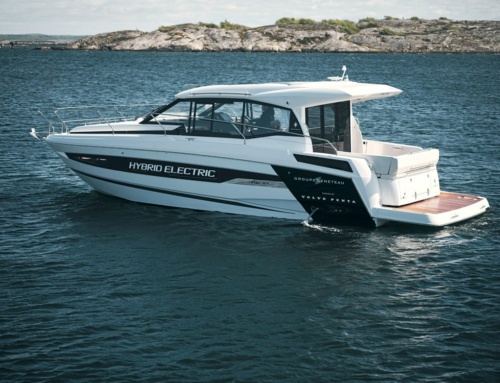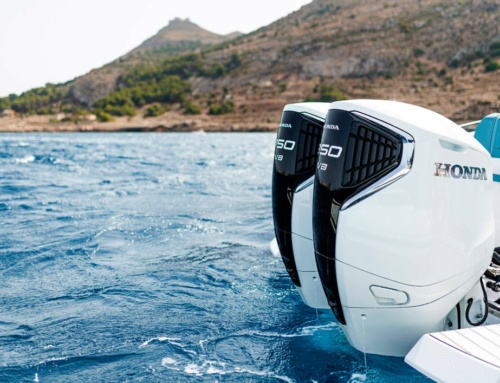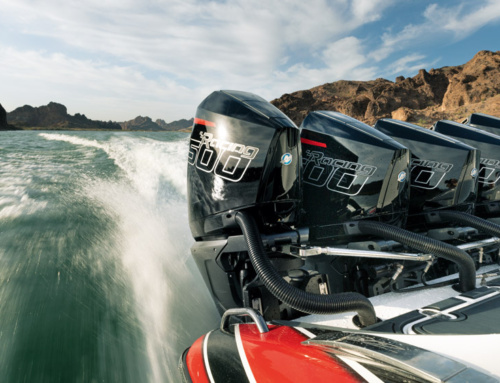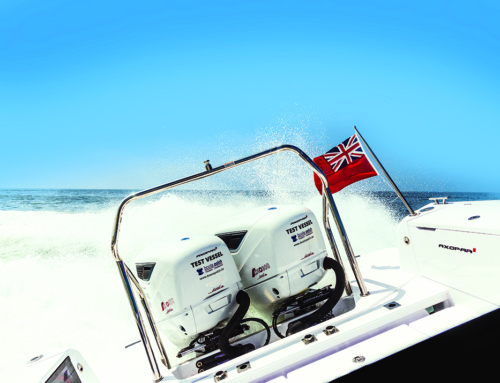- One aspect that is immediately evident about the entire range is how slim these motors are.
- Torque, fuel efficiency and top-end power are produced by a simple menu of displacement, effective fuel injection and advanced electronic engine control.
New Mercury V6 and V8 Engines
Greg Copp explains why Mercury’s launch of their latest generation of outboards is a game-changing shift.
Given that Mercury had pioneered supercharged straight-six 4-strokes and direct-injected 2-strokes for many years, these exciting new engines have taken much of the industry by surprise. These new models are based on two sizes and configurations, a 3.4L V6 and a 4.6L V8, and all use four valves per cylinder and double overhead cam (DOHC) cylinder heads. There is a modular theme throughout the range, starting with the block itself, as the 64-degree V8 is a V6 with two extra cylinders. All motors will be sold under the brand lines of FourStroke, Verado, Pro XS and SeaPro, as well as the Mercury Racing brand. Power varies from 175 to 300 hp, and all engines are rated to run on 87 octane petrol, though they will be slightly more efficient on the higher-octane fuel available in the UK.
Torque, fuel efficiency and top-end power are produced by a simple menu of displacement, effective fuel injection and advanced electronic engine control. On this last note, the ECU detects when the helmsman is running at a constant speed, to produce an effective lean fuel/air mixture. The old saying that there is no substitute for displacement seems to run true with this engine range, though it is clear that Mercury are keen to emphasise that this displacement only works so well because of the technology feeding and controlling it.
I am surprised that they have not used direct fuel injection (DFI) as Yamaha have done with their new XTO 425. This has been used in cars for over 12 years and is proven to be more fuel-efficient than conventional sequential fuel injection, where the petrol is injected into the inlet manifold runners. I understand that Mercury rejected DFI for cost and reliability reasons, which I can accept for the former but not the latter reason. For more torque and better hole shot performance, Mercury are using what they term ‘transient spark ignition’, which they claim will give the engine 5% to 7% more torque at the low end.
Another interesting feature that is common to some of the range is what is called the ‘Advanced Mid-Section’, or AMS for short. This is simply an advanced transom mounting system, which puts on a few pounds over the Conventional Mid-Section (CMS) mounting system. Developed initially for the new Verado, it is also available for the SeaPro, and enables the Mercury Joystick system to be used. It pushes the engine slightly further aft and, as a result of its advanced engine mounting system, reduces vibration. In this regard I can confirm, having sat in the back of an Axopar 37 powered by twin 300hp Verados, that the AMS appears to work. Watching the engines, I could see that they were able vibrate, yet isolated within the cradle-like AMS.
One aspect that is immediately evident about the entire range is how slim these motors are. This is helped by the centrally routed exhaust system, which by its nature also reduces weight, and helps lower engine noise through containment. The exhaust manifold is in the middle of the 64-degree V, instead of being on the outside. This has allowed the cowl width to be slimmer so that the motor can be installed 26 inches, centre to centre. However, the most interesting and unique aspect of the exhaust on the V8 is the multi-chamber muffler system located on either side of the midsection, which connects to the idle relief port on the back of the engine. This otherwise innocuous exhaust outlet develops a new character courtesy of an electronically controlled bypass valve. At the flick of a switch, the exhaust exits through one of the mufflers, as well as directly through the relief port. You get to hear what a V8 sounds like in earnest, which to a point is great. This is probably why the ‘Sports Exhaust’ facility stops at 2500rpm, as beyond this, what was a great V8 rumble can become an intrusive howl.
The gear case on the FourStroke and Pro XS outboards is a sleek, low-drag 4.8in unit. However, the Verado and the SeaPro have 5.4in gear cases as standard. This robust gear case, developed from the proven gear case used for the previous supercharged Verados, is also available as an option on the other two engines. All have 85-amp alternators capable of putting out 20 amps at idle speed. However, with the wide selection of on-board electronics being fitted to boats, power drain at low speed often exceeds output. Fishing is a good example of this. To cope with this need, there is an idle charge battery management system, which automatically increases idle speed to produce more amps as needed.
Driving the 225hp 4-stroke V6
At the press launch on Lake Maggiore in Italy, we were not officially allowed to actually drive the demonstrators. However, XO Boats were keen to oblige PBR. As they fit Mercury engines, they had their XO 270 Cabin OB fitted with twin 225hp FourStroke V6s at the event. This Finnish-built, deep-vee aluminium boat was a perfect test bed. Displacing just 2250kg (dry), the light 225hp V6 at 216kg is a perfect match for it. It is a relatively quiet engine, though it has a reassuring V6 growl when you load the engine and punch up onto the plane and beyond. It has a lot of low-down power without a shadow of a doubt. It is hard to make exact comparisons without an immediate back-to-back comparison with another engine, but the only other comparable engine I recall having such bottom-end grunt was the 2-stroke 200hp E-Tec G2. You can start to feel it really getting to grips as low as 2500rpm, with superb engine response. At 3000rpm the motor is itching to light up and take off – which it did. The V6 hammers up to its 6000rpm redline, which in a boat like the XO 270 means you are past 40 knots in 12–15 seconds, and with the leg trimmed out we managed 48 knots.
I got a chance to try out the ‘Adaptive Speed Control’ where the ECU maintains a constant engine speed – for example, in the tight turns I was putting the 270 through, or in rough weather if need be. This is great for water sports when you want to maintain a constant speed for the skier. However, I was hell-bent on throwing the sure-footed XO through a series of tight turns, at which it excels, and then using the abundance of torque to punch out as fast as possible. Mercury are right to rave about this engine – it is a corker. It is just a shame that the only chance I got to sample the 300hp V8 was as a passenger hanging around the transom listening to its fairly muted yet seductive V8 growl.
Servicing
A noteworthy feature of this new outboard line is the unique watertight hatch in the top of the cowl, which provides access to the dipstick as well as the oil filler. This means easy oil checks without having to lift off the engine cowling while hanging off the back of the boat. If you do want to remove the cowling, an easily operated catch under the watertight hatch releases catches all around the inside of the cowling. With this removed there is a diagrammatic decal outlining service requirements and their intervals, along with a QR code to allow a smartphone to link to additional service information. Once the cowl is removed, most service points are apparent: the oil filter is easy to spot near the fuse box on the port side, the spark plugs are arranged in neat columns and the fuel filter comes easily to hand on the starboard side.
250R and 300R
These two engines replace the 2-stroke V6 250XS and 300XS, and by their nature are slightly ‘trick’ compared to their more conventional counterparts. They both use the new 4.6L V8 engine block and produce substantial torque increases over their 2-stroke predecessors, mainly as a result of their 44% increase in capacity. They also achieve savings over the earlier engines due to ‘state-of-the-art powerhead components and composite inlet manifold runners’. The 300R specifically features racing intake camshafts and valves, as well as an exclusive short runner intake manifold – which increases intake charge velocity at high RPM. An integrated oil cooler keeps oil temperatures down through the Racing engine’s exclusive maximum operating range of 5800rpm to 6400rpm. There is a selection of gear case options, including the proven Sport Master gear case, and two different engine midsections, all offered in different shaft lengths. The weight is a sprightly 232kg in its long-shaft form, making the 300R the second-lightest 300hp engine in production, behind the 300hp Pro XS. The warranty is three years, though this might be extended in the near future.
FourStroke series
The 250 and 300 hp FourStroke outboards are built on the 4.6L V8 platform, while the 175, 200 and 225 hp FourStrokes are built on the 3.4L V6 block. These engines are designed for sports boats and RIBs and are in effect a ‘middle of the road’ outboard for the average leisure boater. They come with the CMS, so they are not capable of being rigged with Mercury’s Joystick system. The weight for the 300hp V8 is an impressive 239kg in long-shaft form, and the 216kg long-shaft 225hp V6 is the lightest engine in its class. The warranty is the usual five years.
Pro XS
These engines replace the Optimax 2-stroke range and are aimed at the US tournament fishing market, or at those wanting high performance without going down the route of buying a 250 or 300R. Fitted with the sleek 4.8in gear case as standard, you can opt for the tougher 5.4in Torque Master Gear Case. This range starts with a 175hp V6 and then moves to the V8 engine for the 200, 225, 250 and 300 hp models. The maximum power range for the V6 is 5400 to 6000 rpm, while the V8 runs at between 5600 and 6200 rpm for wide-open throttle. The 175hp V6 weighs 213kg, and the V8 in versions is the lightest 300hp engine in production at 229kg – both long shafts. The warranty is the normal five years.
SeaPro
Designed for commercial applications, these motors are more ruggedly constructed. There are also options that are not available with some of the other models. This line gets a 200hp engine based on the 3.4L V6, and three versions of the 4.6L V8: 225hp, 250hp and 300hp models. Both the AMS and the CMS are available on SeaPro outboards. With the CMS, the long-shaft 200hp V6 weighs 220kg, and the long-shaft V8 in all forms tips the scales at 239kg. The AMS increases the weight by 33kg. The warranty is three years or 1500 hours – whichever comes first.
Verado
The new naturally aspirated V8 Verado is named after the L6 supercharged engine it replaces. Because of its large-displacement V8 lightweight engine, it is considered to be on a par with its smaller Verado predecessors. It is top of the range and consequently comes standard with the AMS, a 5.4in gear case, electro-hydraulic power steering and additional sound reduction. It is also the only recreational engine that can use the Joystick Piloting system. The warranty is the normal five years.
Contact
www.barrus.co.uk













